Lots of couples these days are choosing to start their lives together with the beauty and splendor of a traditional Celtic wedding. Whether you are of Irish or Scottish descent or you just have an affinity for the history and magic of a Celtic ceremony, we can help you with some ideas to get your wedding planned.
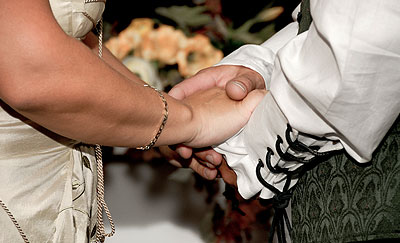
As a modern bride, you can follow an older tradition or create your own to reflect your personal style.
Celtic Wedding Superstitions.
There are so many superstitions surrounding Celtic weddings that it is impossible to list them all. Here are just a few of the more popular:
- It’s considered unlucky to put on your own wedding veil on the big day. If you want the luck of the Irish, have a happily married woman do the honors for you.
- Bad weather can bring good luck, according to tradition. Don’t worry about a little rain on the big day. According to Irish legend, this is the guarantee of a happy marriage.
- You can put an Irish penny in your shoe to bring yet more good luck.
- A horseshoe should be sown into a wedding gown or tucked into the bouquet for luck.
- Every couple should receive one bell as a wedding gift, where it can be placed in the home and rung to end the discord of an argument by either spouse.
- It was lucky to hear a cuckoo on the wedding morning.
- The earrings you wear on your wedding day will bring you luck and happiness thereafter.
- It is good luck to tear your dress accidentally on your wedding day.
- Marry in May; rue the day.
- Marry on Monday for wealth, Tuesday for health, Wednesday the best day of all, Thursday for crosses, Friday for losses and Saturday no luck at all.
Celtic Rings
If you want to show your future bride how loved she is, consider selecting an engagement ring of Celtic design, perhaps with a Claddagh, Celtic knot or Serch Bythol design. Claddagh engagement rings are a fine tradition coming from Claddagh, a fishing village in Western Ireland. The ring is handed from mother to daughter and used both as the betrothal and wedding ring. Wear it with the crowns facing inward, toward the wrist, on betrothal, and outward, toward the nail, upon marriage. Today, it is still used as a wedding ring and it is considered improper for a person to buy one for him or herself; it must be given as a gift.
It is good luck for the bride to have her birthstone in her engagement ring, even if the stone is otherwise thought unlucky. If you wish to skip a jeweled extravagance, then consider the understated elegance of the Celtic knot or Serch Bythol.
Celtic Knot
When Celtic sailors were at sea, they would spend their free time weaving rope mementoes for their loved ones still at home. The Celtic Sailor's Knot is made of two intertwined ropes joined together as one and has come to symbolize the union of two as one, a perfect description of today’s modern bride and groom.
Serch Bythol
This Celtic symbol of everlasting love is formed from two triskeles, or three cornered knots that denote the body, mind and spirit. The two triskeles, joined together, show a circle, the everlasting circle of eternity. Thus the figure represents two people, joined in body, mind, and spirit in everlasting love.
Celtic Music for the Ceremony
A wonderful way to add a Celtic note to your wedding is to hire someone to play the Celtic harp of the Uillean pipes during the ceremony. You can have the bride piped down the aisle or have a piper lead the couple from the church. Or you could choose an Irish singer or even choose peaceful Celtic music from a recording to be broadcast in the church.
Another choice is to have Celtic instrumental music softly playing, or even folk singers, if you are having a ceremony that leans toward the medieval.
Celtic Ceremony
The first thing you need to decide is whether you will be married in a natural setting or in the church. Ancient Celts preferred the out-of-doors where they could have more of a connection to nature. In fact, ceremonies were more often performed in circles rather than in an aisle, as circles represented the intertwining of all natural elements.
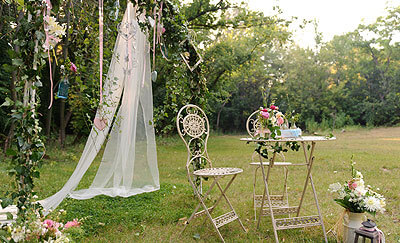
Ancient Celts preferred the out-of-doors where they could have more of a connection to nature.
The drawing of the circle is a very old Celtic wedding tradition. Once the bride reaches her groom, a circle is drawn around them to symbolize the union that they are entering into that day. Couples marrying indoors will have to use a circle of rose petals or a long strand of ivy instead of a circle drawn in the sand or earth.
There are lots of ways to add Celtic charm to your wedding ceremony. You can have a piper play the bagpipes for the processional or recessional music. You can, of course, have a Christian ceremony pronounced in Gaelic, or you can have a Druid officiate (although these can be notoriously hard to find!)
Finally, the age-old tradition of handfasting can be part of the religious or civil wedding ceremony. Make sure if you are marrying in the church that your officiant will approve this addition to your ceremony. Some Christian denominations take a dim view of handfasting.
In handfasting, the hands of the bride and groom are joined as the officiant asks "Who gives this woman to be wed?" and then takes her hand from whoever is giving away the bride and clasps it to the groom’s. The priest or minister would then wrap the clasped hands in the end of his stole to symbolize the trinity of marriage; man and woman joined by God. You may also wrap the clasped hands with a cord, an embroidered cloth, or even a length of ivy.
Celtic Wedding Attire
There are a number of ways to achieve a distinctly Celtic look with your wedding attire. These can run from the traditional Celtic kilts and Irish lace to the splendor of a period ensemble to the imaginative designs of a faery wedding.
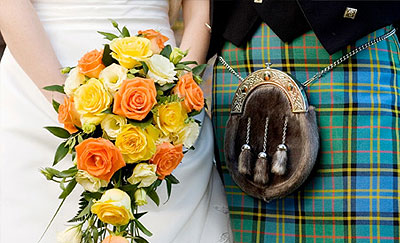
There are a number of ways to achieve a distinctly Celtic look with your wedding attire.
For the Bride:
While green is certainly a color with strong Irish connotations, an Irish bride of the past would have shied away from that color on her special day. Green was thought to attract the fairy folk who, being fascinated by the bride, would cause her mischief. Traditionally, Irish brides wore blue wedding dresses instead of white. Blue was a symbol of purity to the ancient Celts. In fact, it wasn’t until 1499 that Anne of Brittany popularized the white wedding dress.
If blue isn’t your thing, think about having a wedding dress made from, or embellished with, Irish lace. There are also plenty of designers that offer authentic medieval or period dresses that would make a lovely bridal gown. For still more inspiration, you might consider researching your family crest and incorporating its colors into your wedding palette.
Irish brides carried a handkerchief on her wedding day to symbolize fertility. It was usually tucked into the sleeve of the wedding gown or carried with the bouquet. When the wedding was over, the bride would use the kerchief to make a christening bonnet for her first child.
Importantly, most brides would have been barefoot to be in close touch with Mother Earth and as a sign of simplicity and humility.
For the Groom:
Of course, the groom will want to wear a kilt; the family plaid. Although groomsmen may not have kilts, vests or sashes can be made to coordinate. If the groom does not have a family plaid, he may consider wearing a tartan vest or sash also.
Another option for grooms is to wear a period outfit of traditional medieval clothing. This is particularly suitable for the ceremony that leans toward the Renaissance or faery theme.
Wedding Flowers
In Celtic times, English lavender was preferred in bouquets for its sweet smell and to betoken the couple’s love and devotion to one another. Many Gaelic brides wore a wreath of wildflowers in lieu of a veil and carried bouquets of herbs and wildflowers to match.
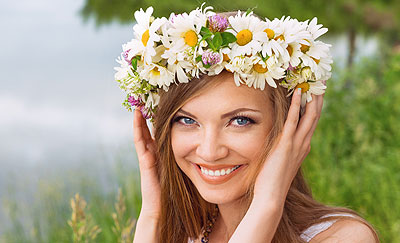
Many Gaelic brides wore a wreath of wildflowers in lieu of a veil.
Celtic brides also tucked a sprig of shamrock into an Irish bouquet or a branch of white heather for the Scottish as each was thought to bring good luck to the bearer.
Floral garlands and evergreen boughs have been traditional since the 19th century and would make a lovely addition to the church altar and pews as well as decoration for head tables and gift tables at a reception.
Transportation at Your Celtic Wedding
Since most Celtic weddings took place in small villages, the bride usually walked to the ceremony, escorted by attendants and following a flower lined path that had been strewn from her house to the church by the wedding guests. After the ceremony, the bride would take a different route home, signifying her start on a “new path”.
If you are marrying somewhere where this is illogical, then consider other options such as a horse and carriage to see you to the church. Or, if you are very adventurous, you and your groom can enter on horseback.
For the more modern-minded, a limousine chauffeured by a driver wearing a kilt or tartan plaid would add Celtic flair to your arrival.
A Celtic Reception
It can be fun to add Celtic touches to your reception with traditional food and drink, decorations, and music. These elements can really capture the spirit of Celtic culture, while also providing guests with unforgettable experience.
Celtic music, from fiddles, pipes, harps and folk singers to modern Celtic pop or rock, can be a great choice for your reception. Check with musicians who play at Irish pubs or Celtic festivals and ask them for a demo tape of live performance to gauge their talent. Music that inspires dancing should be your goal.
To add a little Celtic flair to your reception hall, consider Scottish tartans, splashes of emerald green, pots of shamrocks or Scottish heather on every table, or even Celtic symbols embroidered on napkins.
The traditional Irish couple would have married in the bride's parents' barn, and family pride would have kept the food and drink flowing. In fact, most couples grew up within close distances and a wedding or handfasting would draw friends and relatives who would might travel for many hours to attend, even walking perhaps twenty or thirty miles. This, of course, meant leaving their own chores unmanaged for as long as the journey would take them, possibly resulting in hardship upon their return. Feasting, drinking and dancing would occupy two or three days and it was thought only proper to provide a good meal, good drink and good entertainment to folk who cared for the couple enough to come so far at such cost.
To capture this historic atmosphere, consider selecting a rustic location for your reception and incorporating traditional Irish fare into your menu. Be sure to have plenty of everything.
Celtic Wedding Feast
At ancient Irish weddings, the groom and bride protected themselves from evil by consuming salt and oatmeal before the wedding feast began. During the feast, the new couple were presented with, and drank from, a large goblet with two handles called a "quaich", as a symbol of the joining of their families. The quaich was most likely filled with a honey wine called "Bunratty Meade".
Although “Celtic” is typically a description that applies to Irish culture, it does extend to Scotland as well. Potatoes are the cornerstone of this cuisine and make a statement when served in traditional ways such as colcannon (potatoes and cabbage) and boxty (potato pancakes). An Irish stew or serving of Scotch broth would warm the bones and delight the palate, as would any hearty beef or lamb dish.
Other foods that fit well in an Irish wedding feast include soda bread, salmon, and prawns.
Traditionally, an Irish wedding cake is a three-layer, whiskey-laced fruitcake with almond paste spread on each layer. The top layer is preserved to eat at the christening of the couple's first child. You should check with your baker early -- depending on the recipe, an Irish wedding cake may need to sit for several months before it is ready to be eaten.
If you wish to opt for a more traditional flavor of cake, such as vanilla or chocolate, decorate it with sugar shamrocks or add wild roses or Scotch heather blossoms for a Celtic touch.
For drinks, consider serving mead or whiskey along with traditional Irish tea, for those who abstain.
Celtic Wedding Favors
One longstanding Irish wedding tradition is to place a small serving of the wedding cake into small boxes labeled with the couple's names and the wedding date, so the guests can take away a small memento of the special day.
Perhaps to make it distinctively Irish you could seal the boxes with your favorite Celtic symbol such as the Claddagh or Celtic knot.
Another traditional way to give Irish wedding favors is to place little charms within the wedding cake itself. Traditional charms such as a ring, a thimble, a button, a dried pea, and a coin are fun, but you can use any charm that suits your particular decor.
For the more modern celebrants, it would be entirely appropriate to give gifts of Irish tea or linen; such as Kenmare, Limerick, Carrickmacross or Yougal lace, and perhaps a sampler of sweet Butler’s Irish chocolates. If you can’t afford luxury chocolates, you can order plain chocolate in Celtic shapes.
Finally, consider giving the gift of music by offering your favorite Celtic tunes on CD
A Celtic Honeymoon
Of course, your honeymoon should be a destination that you both agree on. But if you’ve planned a Celtic wedding, why not extend the theme with a honeymoon trip to Scotland or Ireland. There are many beautiful castles that can be rented for a stay, as well as cozy cottages and charming bed-and-breakfasts that would make the perfect honeymoon destination.
Take a sightseeing trip to historic Celtic locations, check out your heritage, or simply enjoy the lovely views, interesting places and friendly people.
Another traditional way to give Irish wedding favors is to place little charms within the wedding cake itself. Traditional charms such as a ring, a thimble, a button, a dried pea, and a coin are fun, but you can use any charm that suits your particular decor.
Popular romantic sites in Ireland include, Inistioge in County Kilkenny, the Cliffs of Moher in County Clare and Connamara in County Galway. Scottish romance can be found at Dalhousie Castle, outside of Edinburgh, and the Isle of Skye off the northwestern coast of Scotland.

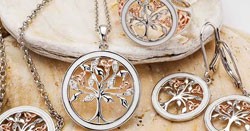
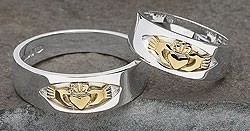
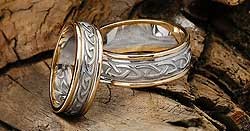
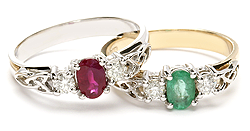
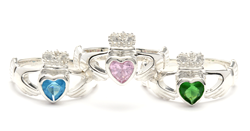
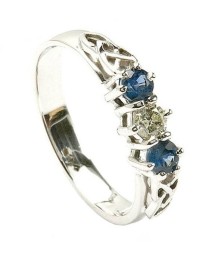 Sapphire Engagement Ring
Sapphire Engagement Ring  3 Stone Diamond Ring
3 Stone Diamond Ring  Emerald 3 Stone Ring
Emerald 3 Stone Ring 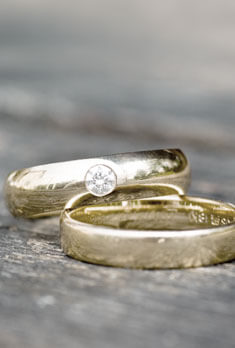

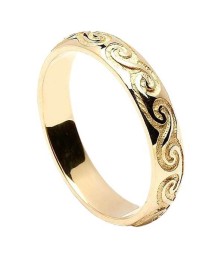 Celtic Spiral Wedding Band
Celtic Spiral Wedding Band 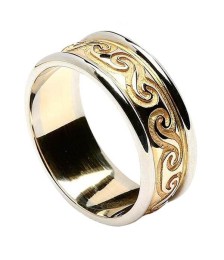 Spiral Band with Trim
Spiral Band with Trim 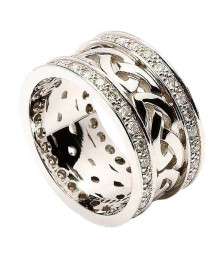 Celtic Ring with Diamond Trim
Celtic Ring with Diamond Trim 